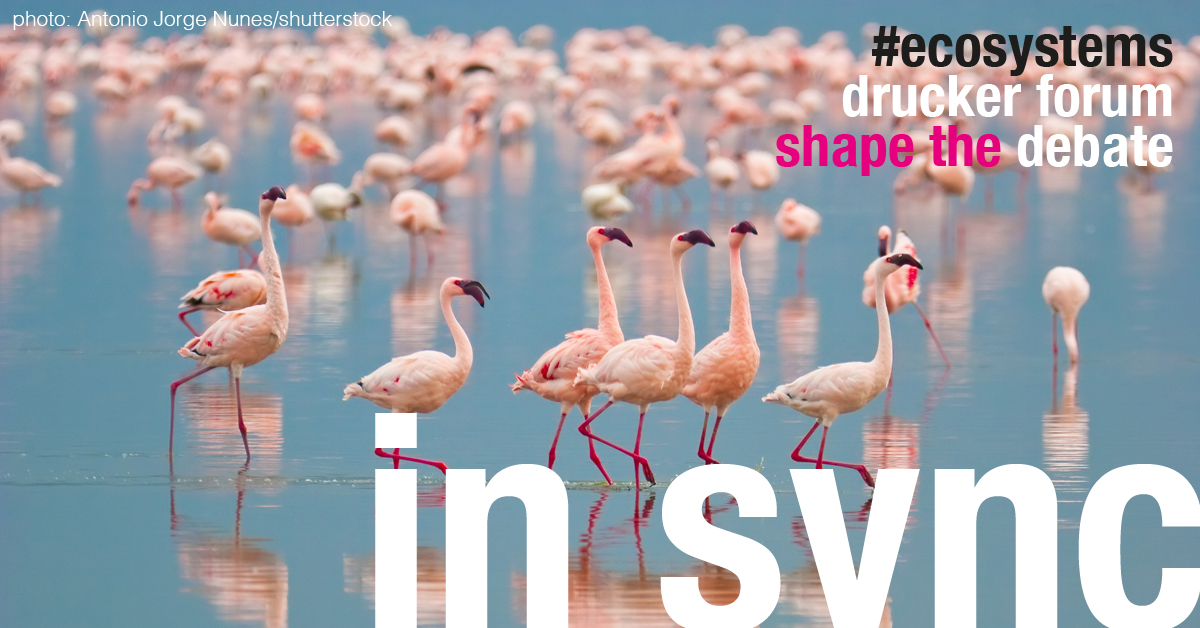
A powerful emerging approach is to describe the organization as an ecosystem. Leading the mechanisms of that ecosystem is a new paradigm shift, and one crucial element is the rhythm of business and connections.
Alignment and synchronization across teams, departments and business units is obviously harder when you do not have the classic, command-and-control, top-down approach to sharing information, deciding on tactical activities, funding and sponsorship, distributing tasks and resources, assigning tasks to teams, and following up on status and progress.
With the absence of these structures, we need to replace cascade-based dialogue with cadence-based dialogue. The key is to keep the rhythm steady.
The rhythm keeps you in sync
The terms ‘rhythm’ and ‘cadence’ refer to having a synchronized way of working and meeting in and across teams. The analogy is that of a band or orchestra, playing in the same tempo, in sync with each other but with room for individual or group elements.
Classic management communication is cascade-based dialogue, delivered through the hierarchical structures. The purpose is to get the message out there, fast
An ecosystem requires cadence-based dialogue, which needs a rhythm. The purpose is to ensure that the business activities are in synchronization, and that the well-being and development of the organization and the employees, so they can take care of the business
Cadence is pivotal to the synchronization of the business activities in the organization, and for their ability to stay relevant to the market and to each other. This ensures that the purpose, the strategic dreams, the tactical execution and the operational manifestation of activities are aligned.
Where the rhythm of business is about production, rhythm of connections is about people. The more developed, mature and advanced your organization becomes, the more you will see autonomy and alignment starting to take care of the business synchronization.
Drucker Forum 2019
This does not happen spontaneously, but is driven, nurtured and enabled by a consistent and insisting approach to the framework around your teams. Listening, adjusting the rhythm, and making organic changes are the key mechanisms for sustaining a cross-organizational competence of collaboration. Closeness, relevance and frequency of touchpoints are correlated in this setup. The closer in the network and the more relevant the parties are to one another, the higher the frequency that is needed. Predictability and steady rhythm are at the centre here, contrasting the responsiveness obtained from this.
Building the ecosystem; feel the rhythm
The consistency and buy in to the rhythm in the ecosystem is to strengthen dialogue, increase trust and fellowship, and increase the tactical and operational execution.
Modern ecosystems consist of mechanisms for supporting the flow of information to and between the teams, for rhythms for staying in sync with each other, and for handling the cross-pollination of ideas and knowledge between teams and people.
Leading Ecosystems is a fundamentally different approach to collaboration. It focuses on small teams, White Space mastery, and networks between people. It is a means to withstanding pivotal business changes and to staying relevant and healthy.
It all starts with feeling the rhythm.
About the Author:
Erik Korsvik Østergaard, M.Sc. is a Leadership advisor, author, and founder of Bloch&Østergaard
This article is one in the Drucker Forum “shape the debate” series relating to the 11th Global Peter Drucker Forum, under the theme “The Power of Ecosystems”, taking place on November 21-22, 2019 in Vienna, Austria #GPDF19 #ecosystems


Sounds very theoretical when phrased like this